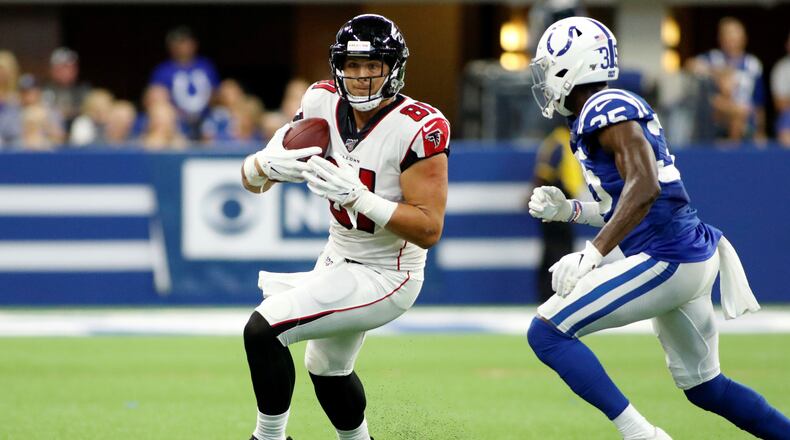For all the times that football coaches say that players improve the most between their first and second seasons, Austin Hooper has a news flash: maybe not. Perhaps they just keep getting better and better for years.
After catching six passes for 66 yards and two touchdowns in Sunday’s loss at Indianapolis, he and Baltimore’s Mark Andrews rank third among NFL tight ends, with 19 receptions through three games. Oakland’s Darren Waller (who played at Georgia Tech) has 26 and the Giants’ Evan Engram 23.
So, having gone from 27 targets and 19 receptions as a rookie after he was drafted in the third round in 2016, to 65 targets and 49 receptions in ’17 and 88 targets and 71 receptions last season – when he was a Pro Bowl alternate -- The fourth-year pro from Stanford is trending the right way, and at a great time.
His contract’s up after this season, and he has every plan to continue improving.
“My understanding of the playbook and situations of that nature, the X’s and O’s in terms of my development has gone up,” Hooper explained. “I think that’s lent itself to me getting more opportunities – just understanding the game better ...
“You’ve got to fill up your bank with lots and lots of reps. I feel like I’m continuously getting better. It’s a position that I don’t feel I’ll ever really master. I just try to get better every day.”
Tight ends coach Mike Mularkey won’t argue.
Hooper’s 22 targets trail only the 30 of All-Pro wide receiver Julio Jones among Falcons, and they share the team lead with 19 catches each. Sure, the 18.4 fantasy points he scored last week are great, yet coaches are more pleased that Hooper’s 86.4 percent catch rate is 16th among all NFL players in the NFL and No. 2 among tight ends behind Waller (89.7 percent).
“First of all, he’s where he’s supposed to be, (and) how the coverages and games have unfolded have had a little bit to do with the production,” the coach said. “He’s been where he’s supposed to be and made the plans when he’s been asked.”
Hooper caught six of the seven balls Matt Ryan sent in his direction Sunday, three for first downs and two for scores.
He was in better position to make those plays than he would have been last year, and certainly better than when he was a rookie – because he keeps learning.
After the 2016 draft, he wasn’t able to join the Falcons until training camp because he was in school into June at Stanford. He missed the spring/early summer offseason work with the team.
Once he became a pro, he had to cram all over against as if studying for football finals.
“It’s a very mental position because you have to be in both worlds – the receiver/route-running world and understanding how to read coverages on the run, and manipulate defenders vs. man and zone,” Hooper explained. “At the same time you’ve got to be able to block a 300-pounder and move them in the run game, so there’s a lot on your plate.
“Being a rookie, I didn’t have OTAs. I didn’t show up until training camp. I had to learn all those route running skills, in-line blocking and blocking in the open field because you’re going to be split out.”
Although he missed the final two games of his rookie regular season, Hooper showed up in the postseason and caught touchdown passes in the playoffs against the Seahawks and in the Super Bowl vs. the Patriots.
His role grew the season after that, as tight end Jacob Tamme, who was injured the latter half of 2016, moved on.
That doesn’t mean former offensive coordinator Steve Sarkisian featured him exactly as new coordinator Dirk Koetter has.
“Sark looked at the three world-class receivers we have and said we should feature those guys. I don’t blame him for it,” Hooper recalled. “Dirk’s just a different play-caller, likes to spread the ball around.”
Actually, Hooper’s ramped up numbers appear to be a function of both play-calling and him working into better spots.
As quarterback Matt Ryan said, “I think Austin has played really well for us. He’s been very consistent in the pass game. He’s very reliable. When we target him, he’s coming down and making plays with the ball ...
“There are situations where we like him and the matchups that he gets for us is a win for us, and then there are times where we’re looking somewhere else and we’re coming back to him. It’s a number of those factors.”
Jones said Hooper has grown enough to where his presence is helping the wide receivers in some situations. At 6-feet-4, 254 pounds, there’s plenty to target, and his route-running skills keep getting better.
“No doubt. I feel like everybody helps each other out. Hoop’s been doing a great job for us, scoring touchdowns, getting targets ... you can’t have a linebacker on him, or a safety,” Jones said. “If so, we’re going to keep throwing him the ball.”
In some ways, Hooper had ideas his workload would increase this season. Although he said his route tree in this playbook is about like it was last year, he’s climbing more branches.
“On paper it’s similar, but I’m actually getting to do more on game day,” he said. “I’m definitely getting to do more stuff on game day than I was in the past.”
About the Author
Keep Reading
The Latest
Featured

